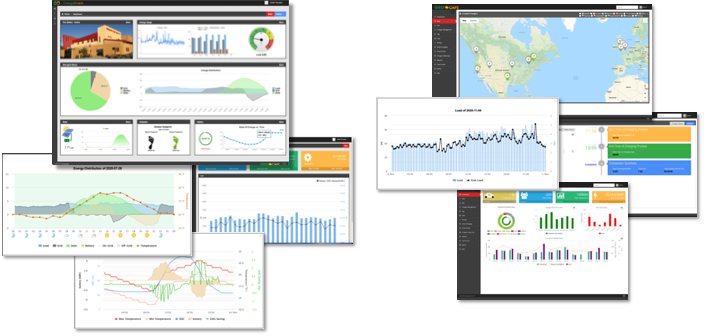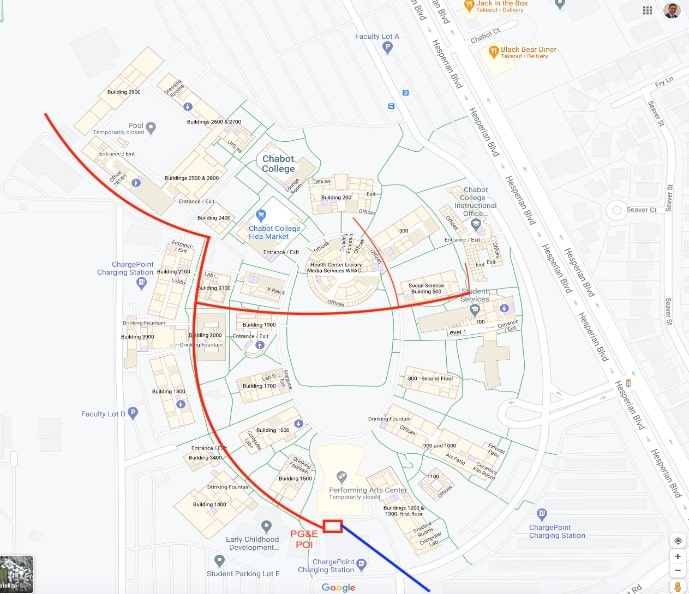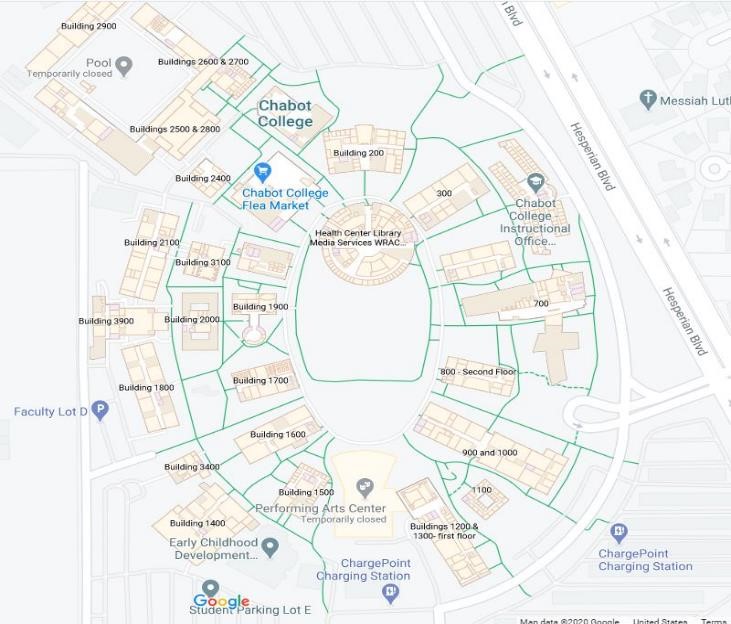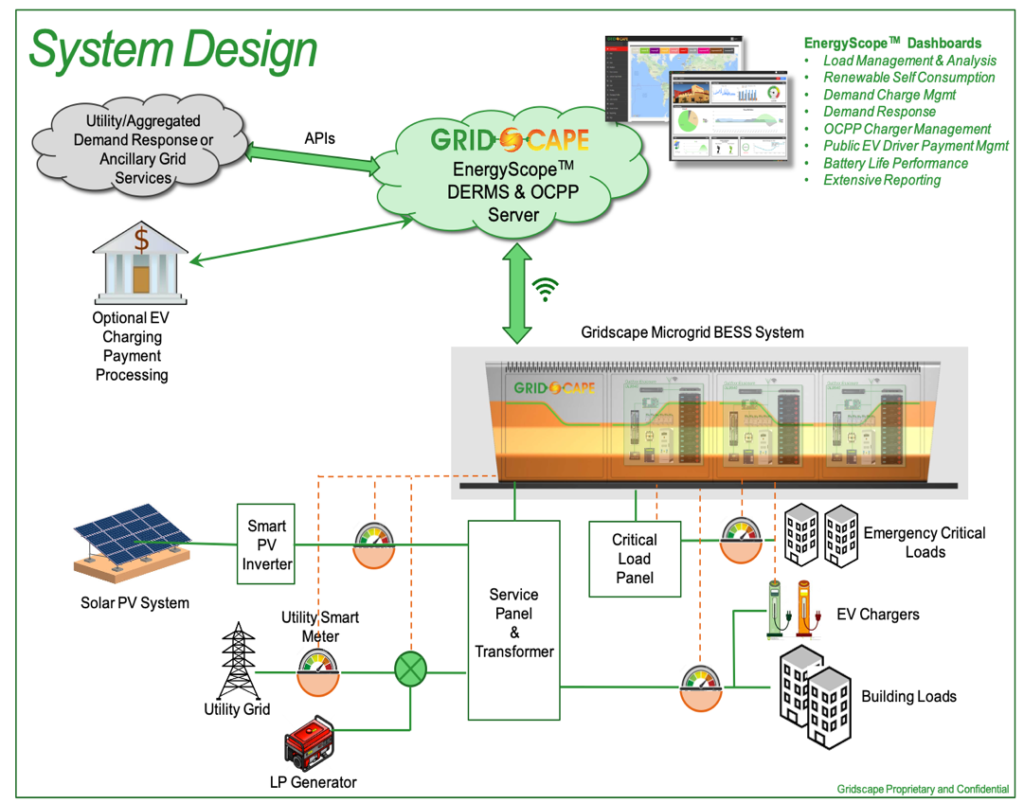Energy independence on campus with
local sustainable power plant.
Case study – Chabot College
On-campus local sustainable power plants can help campuses to shift to 100 % green energy. Campuses around the United States serve more than 20 million students, making them big energy consumers and this makes a campus an ideal place to champion the green energy transition.
Founded in 1961, Chabot College is a student-centered community college that caters to the educational, professional, job skill, and personal development needs of the students. The college serves over 14,000 students within a campus of 94 acres, which includes 25
buildings.
Chabot Positas Community College District College collaborated with Gridscape to set up a microgrid solution for one of the two community college campuses.
The goals of this project are:
- Achieving climate action goal
- Cost Savings
- Resiliency
- Grid reliability
- Increased renewable generation
- EV Charging Infrastructure
- Workforce development
- Training and awareness
- Local job creation

Why microgrids make sense for campuses?
On-campus solar energy solutions can help campuses to shift to 100 % green energy. College campuses are ideal places to champion the green energy transition. For campuses, solar power systems offer a dependable source of unlimited, clean energy. While fossil fuels are a finite source of energy, solar power is not.
Also, microgrids can help campuses reduce peak demand charges, which for some institutions can be onerous, accounting for as much as 30%–70% of total monthly electric charges, according to a report from NREL and the Clean Energy Group. Furthermore, campuses can build partnerships with local communities to expand clean energy and can help create clean energy jobs, and bring down costs.
Benefits of a local sustainable power plant (microgrid) for campuses:
- Realise the climate action plan: On-campus solar energy solutions can help campuses to shift to 100 % green.
- Savings: Cost of electricity has risen considerably over the past few years. Because big campuses use a great deal of electricity, they have been the primary victims of these price hikes and microgrids can help considerably with savings.
- Achieve environmental stewardship practises.
- Work force development & green jobs training: Campuses can build partnerships with local communities to expand clean energy and can help create clean energy jobs.
About Gridscape:
Gridscape is the largest and a well-established name specializing in developing and deploying standards-compliant future-proof products and solutions for renewable energy microgrids and fleet charging. Intended to serve as a locally produced sustainable power plant, these microgrids allow sites to become less reliant on the grid by using local sources of energy. They can provide as much as 90% independence from the grid energy, and thus reduce overall energy cost & provide backup clean emergency power during PSPS or other power disruption events. Gridscape with its ‘Product Centric’ approach to microgrids integrated with fleet EV charging solutions allows for lower cost of installation and reduces the time for deployment by substantially lowering integration issues. It expects to deploy and operate over 35 microgrids in California public and commercial facilities over the next 12 months.
Unlike traditional microgrid developers, Gridscape employs a holistic product-centric, artificial intelligence (AI) based software-driven approach to designing, deploying, and managing microgrids. It also integrates Electric Vehicle (EV) charging and other controllable loads into its solution. Through its broad partnerships with various Tier 1 and Tier 2 financiers, design engineering firms, energy storage manufacturers and other renewable energy product providers, it leverages the best-in-class mix of technology and finance to provide maximum return on investment to customers.
Gridscape’s solution is unique, and it differentiates from traditional systems in following manner.
Product Centric Approach (vs Project Centric Methodology) for scalability, maintainability, and longevity of microgrid assets
Software driven architecture resulting into no technology obsolescence and ability to adapt to changing PG&E tariffs and distribution grid conditions.
Dynamically configurable with an ability to change the microgrid operational modes on demand
Energy Information System: A cloud-based distributed energy resource management system (DERMS) that includes
1
Smart AI-based energy management and optimized load and generation dispatch; and
2
Very powerful visualization dashboard for accessing real time and historical data about PV, Storage and EV charging stations.
Inherently Integrated with EV charging infrastructure
Full Energy Management including demand charge reduction, TOU arbitrage, grid services.
Integration with various Cloud platforms such as Google, Amazon for grid services and load management.
Gridscape EnergyScopeTM Dashboards

The Project
Gridscape Solutions is deploying a Microgrid System at the Chabot College in Hayward, CA, and upgrading its 12 kV infrastructure to provide power resilience to any of the 25 buildings on the campus. A grant from California Energy Commission partially funds this project. The project includes 3 MWh of the energy storage system, five new remote operable switches, utility interconnection, and ten new EV charging stations. Further, there is an existing 1MW solar array that will connect to the microgrid system.
1
The project will save approx. $205,378 in energy costs annually and the estimated value of resiliency (VoR) is $348,882.
2
The project will also offset 847 MT of GHG annually.
3
The project will reduce the peak demand and will contribute to additional cost savings.
The college’s primary objectives for deploying a renewable energy microgrid project are cost savings, backup power, sustainability, and EV charging infrastructure.

Chabot College Current “As-Built” Layout
The challenges with Chabot College Project
- Future-proof to accommodate Chabot’s Master Facility Plan for the next five years, including EV Charging
- Allow for a large number of EV charging throughout the campus
- College Executive, shared governance and constituent buy-in
- Account for Red Cross Emergency Center
- Designing a system without disrupting college life
- Microgrid BESS location constraints
- Integrate existing solar and utility infrastructure into design
- Cumbersome and costly DSA approval process
The Solutions
- Software-driven, scalable, expandable, future-proof Design inspired by Santa Rosa Community College (SJRC)
- Engaged faculty, students, and another stakeholder for “buy-in.”
- Reduced cost and disruption by using existing 12kV lines.
- Minimizes trenching, transmission loss.
- Allows for the microgrid to be located anywhere in the campus.
- Replaced old 12kV switch with new, state-of-the-art remote-controllable switches.
- Any building can have backup power; no need to select them in the beginning as critical buildings.
- Flexible Microgrid design allows islanding any campus building.
- Expandable and adaptable for future changes.

The Plan
The goal is to use the current PV array on campus to construct a small microgrid for various purposes. The project aims to load shed peak demand loads by supplying the campus peak load with the battery, lowering the overall energy bill. The project will assist in developing a solution to offer grid isolation and self-operation (islanding) of a small number of buildings on campus in the event of a major power outage that affects our most important demands. Students will be more engaged and understand more about Microgrid Operation and its applications due to the approach.
Design
The project will be based on the system design and architecture with minor alterations as shown in following figure. As of now, the project is in design phase, and it will be ready for DSA review by the end of November 2021.

The approach to execute
1
Make the solar microgrid and other infrastructure on campus adaptive to changing demands, such as additional building loads and expandable EV charging infrastructure.
2
Site survey to determine the current state of infrastructure and what needs to upgrade.
3
Work with all college stakeholders (administrative, faculty, students) to finalize the goals and objectives of the project.
4
For DSA permitting, prepare a permit-ready design (structural and electrical) and safety and logistical assessment of the location.
5
Apply for SGIP funding and Interconnection with SDGE.
6
Prepare for the building once the DSA has issued the permission (Solar, microgrid, EV charges, infrastructure upgrades).
7
Complete construction work in consultation with the College Facilities team.
8
Complete all the necessary tasks to deployment the system.
9
Provide ongoing OAM to operate and maintain the solar microgrid.
